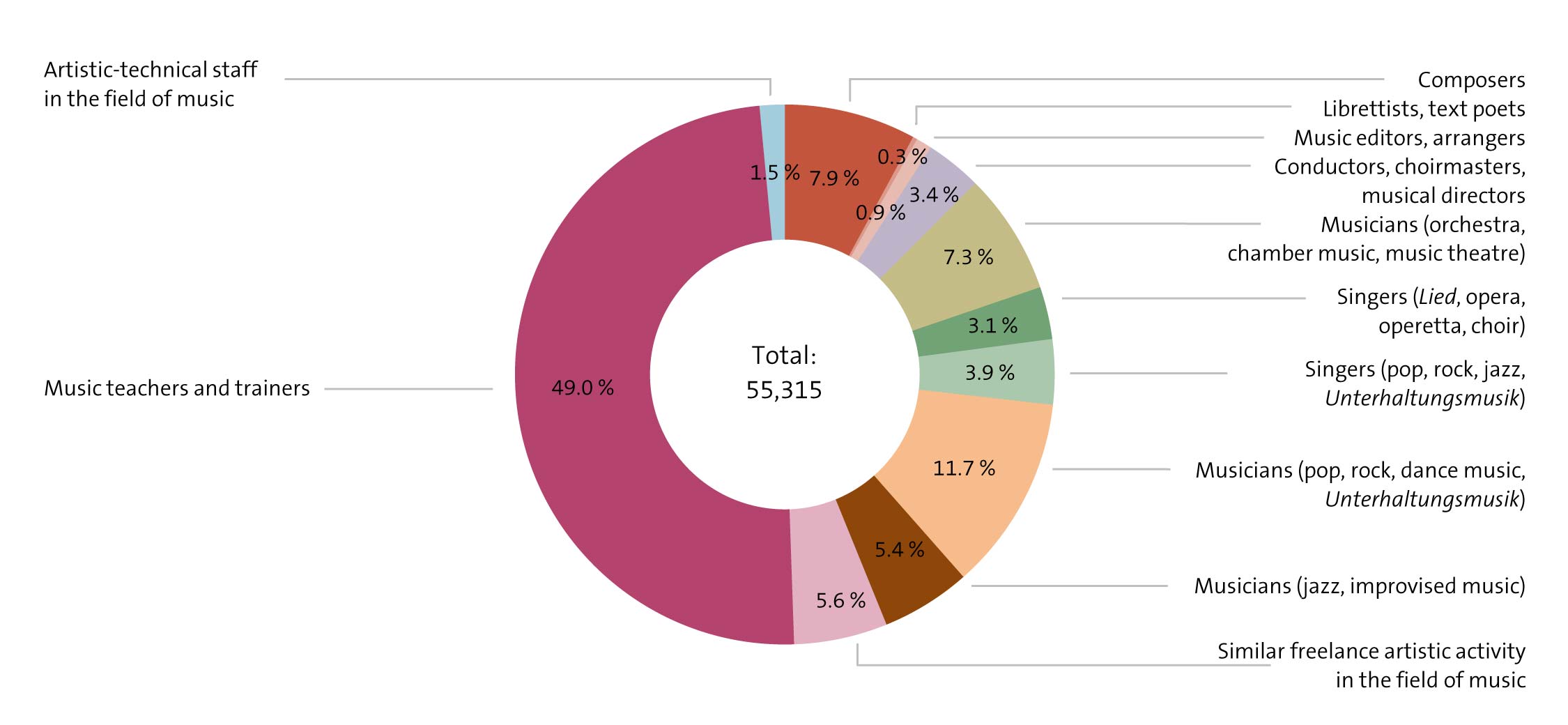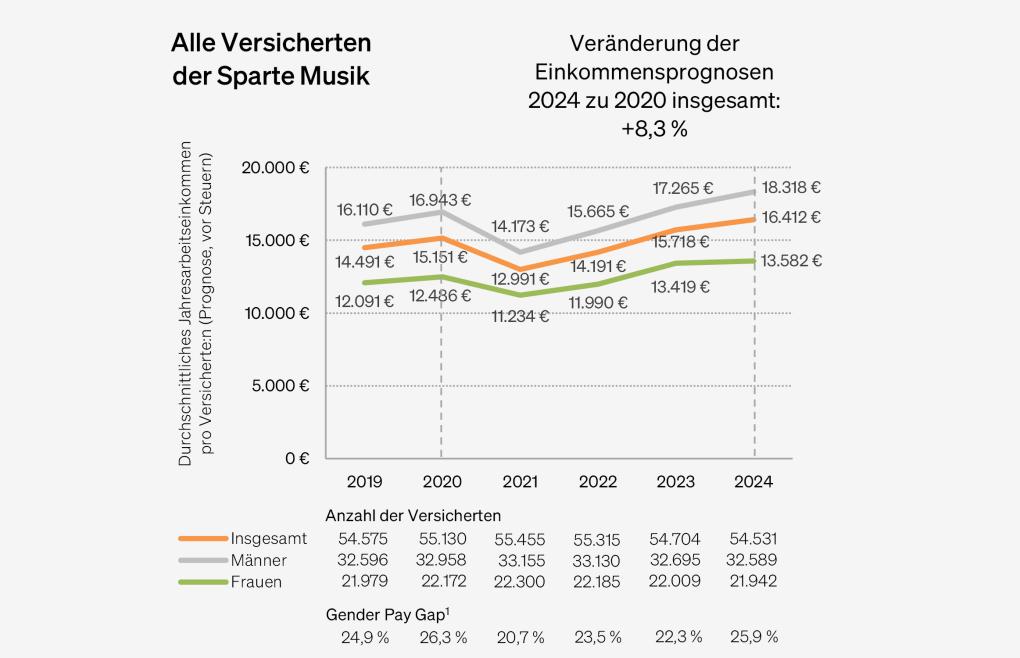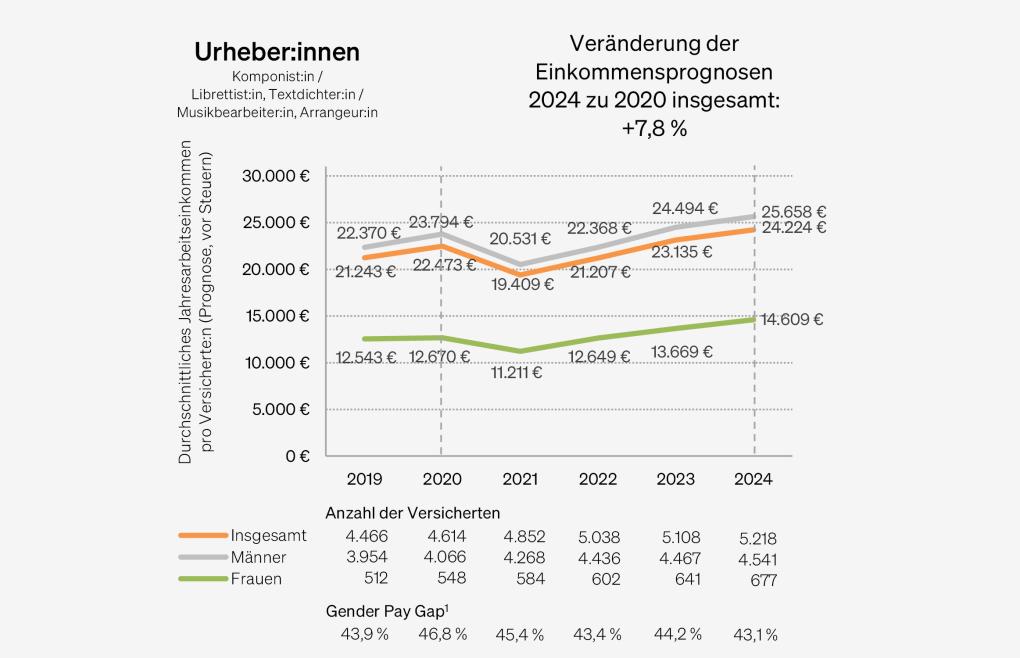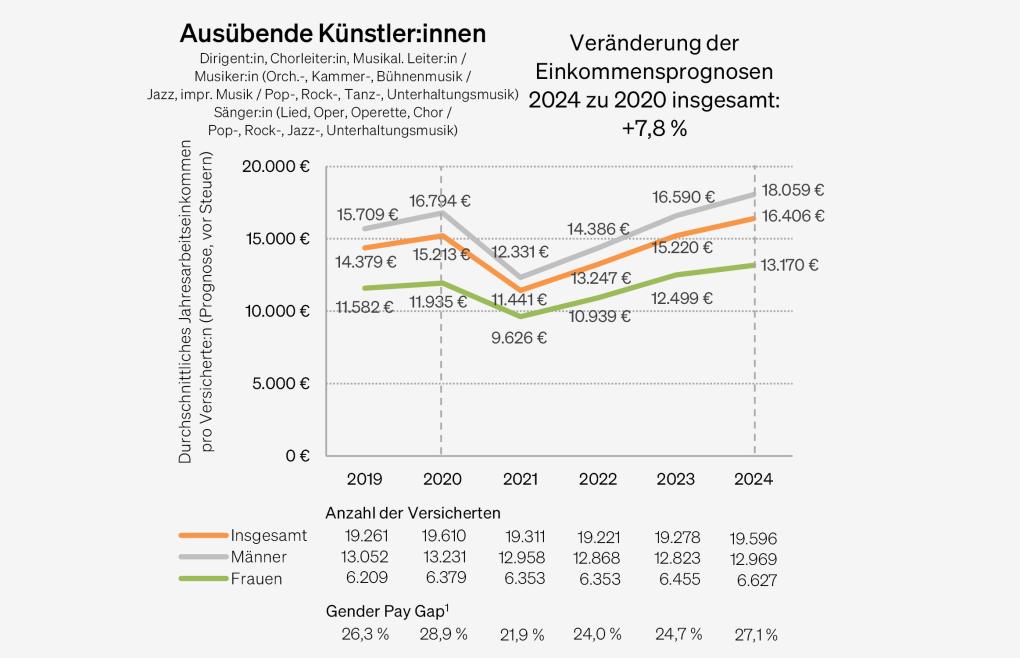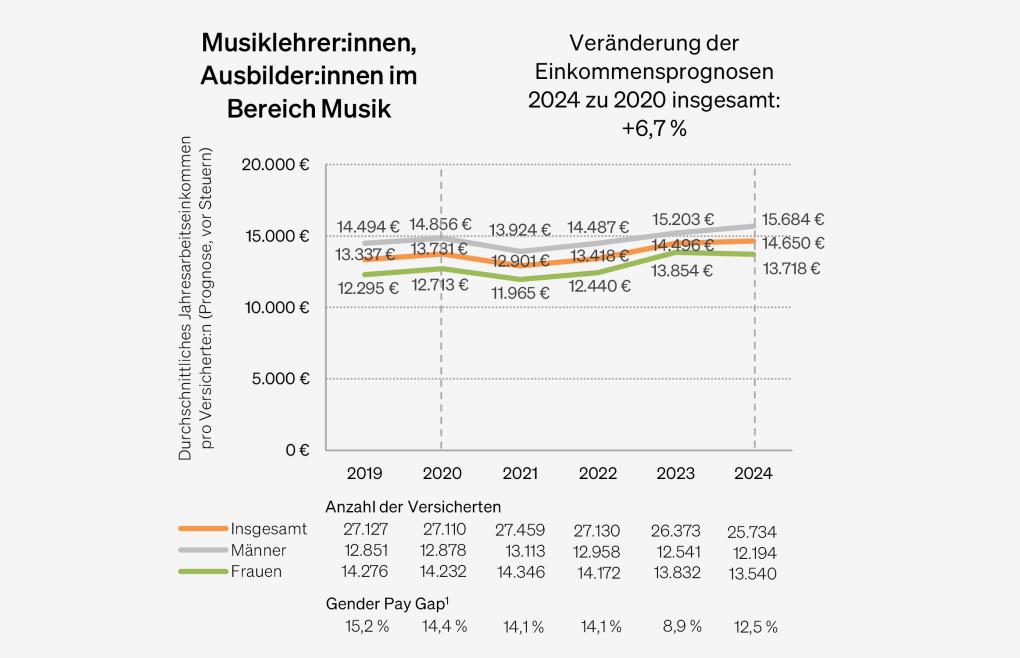The Künstlersozialkasse (KSK), Germany‘s social insurance for freelance artists and writers, reported 55,315 insured persons in the music section as of 12 March 2022. The number of freelance musicians, music teachers and other self-employed persons with artistic or artistic-technical activities in the field of music insured in the KSK has thus remained stable at a high level since 2020. The KSK distinguishes between twelve categories in the music section; about half of the insured are music teachers and trainers.
Insured persons in the music section estimate their income from their main artistic activity at an average of 14,191 euros. The value corresponds to the arithmetic mean of the insured persons' projected income for the year as of 1 January 2022, which is used to determine the individual contribution rate. Also taken into account are subsequent declarations and prognoses of newly insured persons up to 12 March.
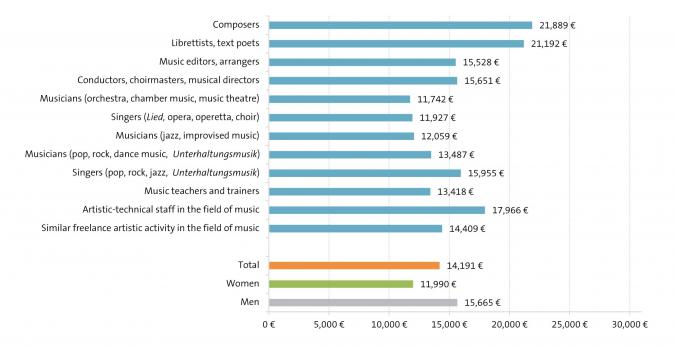
The lowest incomes are expected by performing musicians in orchestras, music theatres and choirs. Here, the estimates are about 11,750 euros in annual income in the category ‘Musician (orchstra, chamber music, music theatre)’ and approximately 12,000 euros in the category ‘Singer (Lied, opera, operetta, choir)’. Jazz musicians (12,059 euros) and rock, pop and dance musicians (13,487 euros) estimate significantly lower incomes than singers in these genres (15,955 euros).
Incomes averaging more than 20,000 euros are expected in the fields of composition and lyric poetry - but only among men. In these fields of activity with the highest earnings, the differences in income between men and women are particularly large.
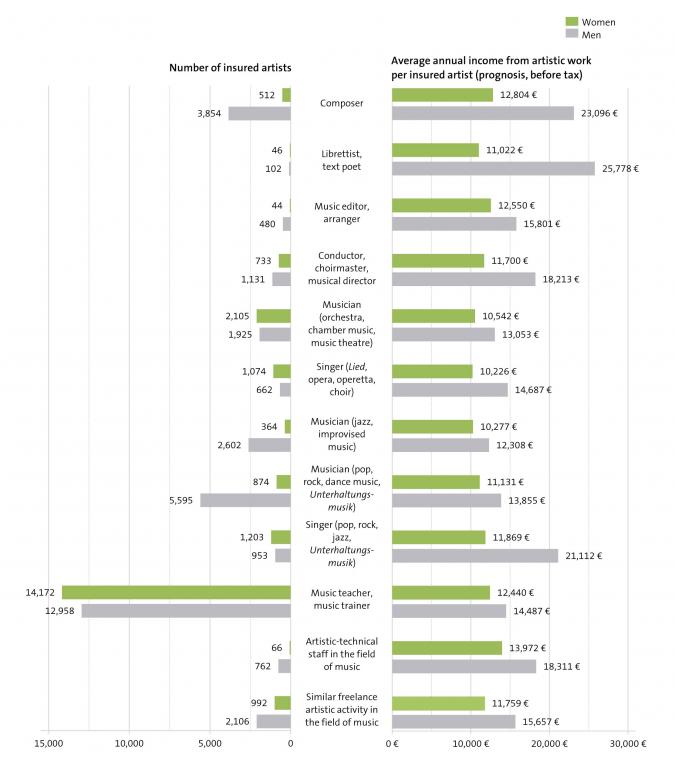
Also among singers in pop, rock, jazz and Unterhaltungsmusik (light music), it is the men who expect an annual income of more than 20,000 euros on average. The average income prognoses of female singers in these genres is 44 % lower. Overall – as in previous years – the expected incomes of men (for 2022: 15,665 euros) and women (11,990 euros) differ significantly. The income prognoses of women are lower in all fields of activity, regardless of whether they make up the majority of the insured in a field or not.
Entwicklung der durchschnittlichen Jahresarbeitseinkommensprognosen nach zusammengefassten Tätigkeitsbereichen der Sparte Musik und Geschlecht
After the slump in the pandemic year 2021, the income prognoses for 2022 are higher again, but they do not yet reach the pre-pandemic level. While the KSK data for 2021 provided the first information on employment and income of freelance musicians during the COVID‑19 pandemic, the data for 2020 reflected the situation before the pandemic breakout in Germany. The comparison between 2022 and 2020 shows an overall decline in average income prognoses of 6.3 %. The large group of freelance music teachers expects the smallest losses (-2.3 %). Creators expect on average 5.6 % less income in 2022 than before the pandemic. Performing musicians, of whom there were more than 19,200 insured in the KSK in 2022, expect 12.9 % less income. The expected losses in comparison to 2020 range from 5.5 % for conductors, choirmasters and musical directors to 17.2 % for musicians in the fields of pop, rock, dance music and Unterhaltungsmusik.
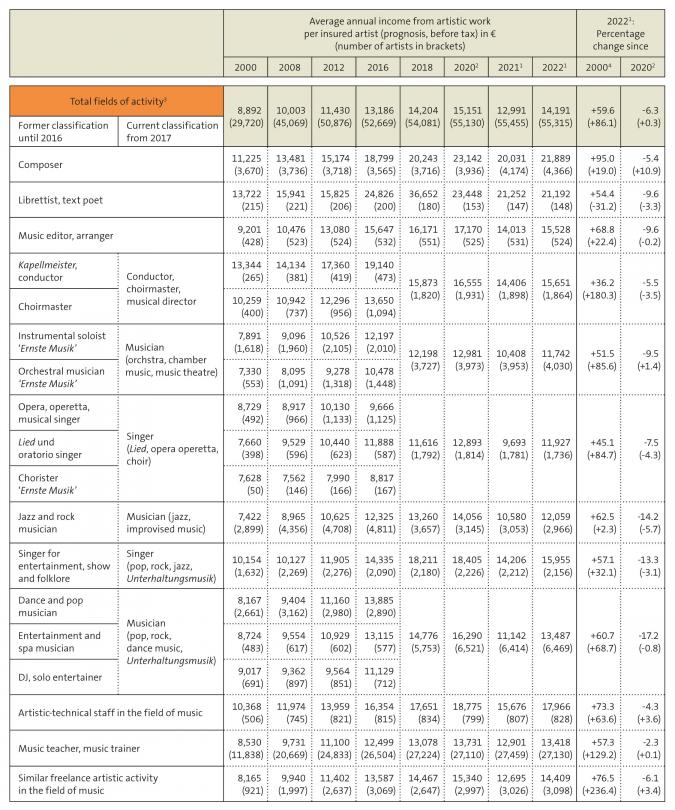
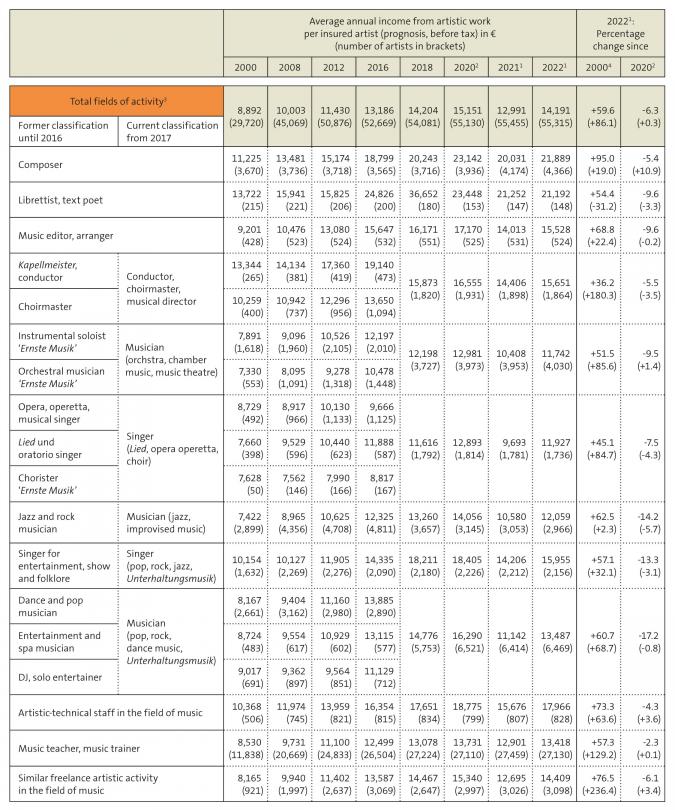
Note
The figures are based on master data of the Künstlersozialkasse (KSK), Germany‘s social insurance for freelance artists and writers. The KSK distinguishes between the four sections music, visual arts, performing arts and word. The data shown refer to insured artists in the music section – irrespective of whether they are insured in all three insurance branches (pension, health, long-term care insurance) or only partially in accordance with the Künstlersozialversicherungsgesetz (Artists‘ Social Insurance Act). A freelance (self-employed) activity is recognised only if artists pursue their main artistic activity predominantly in Germany and their minimum annual income exceeds 3,900 euros (exception: young professionals). If the income falls below this minimum threshold only temporarily (up to twice in a period of six calendar years), the insurance obligation remains in force without interruption. Falling below this limit during the COVID‑19 pandemic is not taken into account.
Not included are journalistic music professions, which are covered by the KSK in the word section and cannot be reported separately, as well as insured persons who earn income in the field of music only in addition to their main activity in another section. In addition to those insured in the KSK, there are other groups of freelance musicians and music teachers whose numbers and incomes are only partially available and for certain occupational groups (cf. statistics ‘Erwerbstätige in Musikberufen nach Altersgruppen und monatlichem Nettoeinkommen’ according to data from the microcensus of the Federal Statistical Office).
The data are collected using a standardised procedure and read out in spring (mid-March). They reflect the average annual income from work from the main artistic activity projected for the current year as of 1 January, which is used to determine the individual contribution rate (before taxes, corresponds to the difference between operating income and expenses; federal and state Corona emergency subsidies paid for self-employed artistic activity are included in the calculation when determining the income prognosis). In addition, the data take into account declarations received after 1 January, as well as income estimates of newly insured persons received up to the readout date in spring. As of mid-March, the numbers of insured persons and income prognoses listed in these statistics differ from the information on the KSK website (‘KSK in Zahlen’, as of 1 January).
When interpreting average incomes, it should be noted that they can be distorted by outliers; this applies in particular to the fields of activity with low numbers of insured artists. The source data do not allow for the calculation of median incomes and other statistical parameters that provide information on income distributions within the listed groups.
Footnotes
-
The income prognoses for the calendar year were submitted by the insured artists during the COVID‑19 pandemic. In their very nature as prognoses, they cannot take into account the actual course of the pandemic and the government decisions on corona protection measures in the calendar year in question. The status of the data is 12 March 2022 (prognoses for 2022) and 13 March 2021 (prognoses for 2021).
-
Prognoses for the year 2020 were submitted by the insured artists before the significant COVID‑19 pandemic breakout in Germany. The status of the data is 14 March 2020.
-
Since 2017, the KSK has used a revised classification of fields of activity. As a result, some fields that were previously listed separately have been combined and completely merged into new categories. These changes are shown accordingly in the table.
-
In cases fields of activity were combined in the revised classification, the calculations of income changes are based on weighted averages of the comparative year 2000.
Source information
Compiled and calculated by the German Music Information Centre from figures supplied by the Künstlersozialkasse (KSK).
